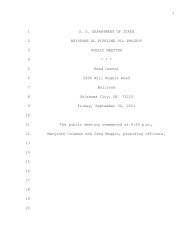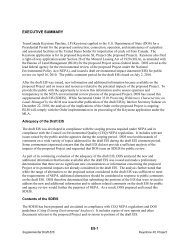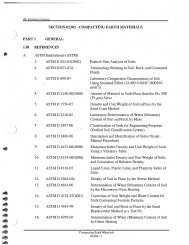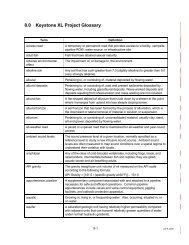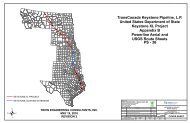2.1 Overview of the Proposed Project - Keystone XL pipeline - US ...
2.1 Overview of the Proposed Project - Keystone XL pipeline - US ...
2.1 Overview of the Proposed Project - Keystone XL pipeline - US ...
You also want an ePaper? Increase the reach of your titles
YUMPU automatically turns print PDFs into web optimized ePapers that Google loves.
Draft Supplemental Environmental Impact Statement<strong>Keystone</strong> <strong>XL</strong> <strong>Project</strong><strong>Keystone</strong> has reviewed <strong>the</strong> NTSB 2012 Marshall, Michigan Accident Report including <strong>the</strong>conditions that led to operational failures on <strong>the</strong> <strong>pipeline</strong> that resulted in <strong>the</strong> spill. <strong>Keystone</strong>would include lessons learned from this spill, including:• Get big quick: timeliness <strong>of</strong> a tactical response to an oil spill into water is imperative. While<strong>Keystone</strong> has stated that it already uses this philosophy, <strong>the</strong> Kalamazoo spill reinforced thisneed to respond with as many resources as possible as quickly as possible. To that end,<strong>Keystone</strong> would strategically store equipment and employ personnel and contractors along<strong>the</strong> length <strong>of</strong> <strong>the</strong> <strong>pipeline</strong> to ensure a maximum <strong>of</strong> a 6-hour response time.• Pre-qualify a large contractor network: Contractors would be used to supplement anyresponse <strong>Keystone</strong> would make to an oil spill. By ensuring a large pool <strong>of</strong> trained/skilledcontractors along <strong>the</strong> length <strong>of</strong> <strong>the</strong> <strong>pipeline</strong> have been pre-qualified and contracted with<strong>Keystone</strong>, <strong>the</strong> response time would be minimized and resources (equipment and personnel)available are maximized.• Emergency response planning details need to include source containment: sourcecontainment plans including strategies and tactics would be included in <strong>the</strong> overarching ERP.• Equipment resources required for sunken and submerged oil: <strong>Keystone</strong> would fur<strong>the</strong>ridentify equipment resources required to respond to sunken and submerged oil and ensurepersonnel are appropriately trained on its use. A primary strategy for oil spill response wouldstill be to contain and recover as much oil as possible as quickly as possible to prevent oilfrom wea<strong>the</strong>ring and <strong>the</strong>refore potentially becoming submerged and sinking. In addition,<strong>Keystone</strong> already owns and practices <strong>the</strong> use <strong>of</strong> containment devices that will preventdownstream migration <strong>of</strong> submerged and sunken oil such as dams. This type <strong>of</strong> equipmentwould be fur<strong>the</strong>r identified and procured for <strong>the</strong> proposed <strong>Project</strong>.In addition, <strong>Keystone</strong> would implement its own company standards and <strong>the</strong> 57 SpecialConditions, which include operational requirements. The proposed <strong>Project</strong> would be constructedto standards that exceed current federal regulatory requirements. In addition to company-specificstandards that exceed current federal <strong>pipeline</strong> safety standards (e.g., typical burial depth <strong>of</strong> 4 feet<strong>of</strong> cover ra<strong>the</strong>r than <strong>the</strong> standard 3 feet depth <strong>of</strong> cover), <strong>Keystone</strong> has agreed to implement anadditional 57 Special Conditions identified in <strong>the</strong> Final EIS. The Final EIS stated that <strong>the</strong>implementation <strong>of</strong> <strong>the</strong>se additional conditions would result in a level <strong>of</strong> safety equal to orexceeding <strong>the</strong> current levels as required by federal regulations.Pipeline conditions along <strong>the</strong> proposed <strong>Project</strong> would be continuously monitored 24 hours a day,7 days a week. The proposed <strong>Project</strong> would have over 16,000 sensors along its length andmultiple, overlapping state-<strong>of</strong>-<strong>the</strong>-art leak detection systems.While flood conditions are not a leading cause <strong>of</strong> <strong>pipeline</strong> failures, <strong>the</strong>y can be a threat to<strong>pipeline</strong> integrity in certain locations. Under federal regulations (49 CFR Part 195), <strong>Keystone</strong>’sIntegrity Management Program is required to monitor and reduce risks from various threats, suchas outside forces due to flooding. <strong>Keystone</strong> has evaluated stream crossings to identify thoselocations where stream scour could affect <strong>pipeline</strong> integrity. Where <strong>the</strong>re is potential forsignificant stream scour, <strong>Keystone</strong> has increased burial depth so stream scour does not pose athreat to <strong>pipeline</strong> integrity. Additionally, under Special Condition 19, <strong>Keystone</strong> is required tomaintain depth <strong>of</strong> cover for <strong>the</strong> life <strong>of</strong> <strong>the</strong> <strong>Project</strong>.<strong>Project</strong> Description <strong>2.1</strong>-71 March 2013



